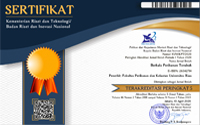Utilization of Probiotic Bacillus sp. and Staphylococcus sp. In Tilapia (Oreochromis niloticus) Seed Maintenance Media for Resistance to Aeromonas hydrophila
Abstract
Keywords
Full Text:
PDFReferences
Agustina,D.T.,Marnani,S.danIrianto,A.2006. Pengaruh Pola Pemberian ProbiotikA3-51 per Oral Terhadap Kelangsungan Hidup Bawal Air Tawar (Collosoma macropomum Bry.) Setelah Diuji Tantang Dengan Bakteri Aeromonas hydrophila. Skripsi. Universitas Jenderal Soedirman.
Ali, A. 2000. Probiotik In Fish Farming: Evaluation of Candidate Bacterial Mixture. Thesis. VattenBruksinintutionen.
Anderson., D. P. 1974. Fish Immunology. TFH Publication Inc. Hongkong. 239 p.
Austin B, Austin DA. 1993. Bacterial Fish Pathogens, Disease of Farm and Wild Fish 2nd. Ellis Herwood. London. 384hlm.
Bachtiar, Y. 2006. Panduan Lengkap Budi Daya Lele Dumbo. PT Agromedia Pustaka, Jakarta, 102 hlm.
Dias, L. P. 2003. Karakteristik Morfologi dan Kurva Pertumbuhan Bacillus brevis dan Bacillus apiarius. Skripsi. Fakultas Kedokteran Hewan. IPB. Bogor. 35 hlm
Dinas Kelautan dan Perikanan. 2008. Produksi Nasional Perikanan Air Tawar tahun 2008. Diakses dari http://www.dkp.go.id/. Pada 16 Maret2015.
Effendi M. I. 2002. Biologi Perikanan. Yayasan Pustaka Nusatama. Yogyakarta. 130 hlm.
Feliatra, E. Irwan, dan S. Edwar. 2004. Isolasi dan Identifikasi Bakteri Probiotik Ikan Kerapu Macan (Ephinephelus fuscogatus) dalam Upaya Efisiensi Pakan. Jurnal Natur Indonesia. Vol 6 No.2. Hal 75-80
Fidyandini, H. P. 2015. Pemberian Probiotik Multispesies Melalui Media Budi Daya Ikan Lele Dumbo (Clarias gariepinus) untuk Pencegahan Penyakit Aeromonads Septicemia. Tesis. Program Studi Ilmu Akuakultur. Pascasarjana IPB. Bogor. 8 hlm.
Gomez, G B., A. Roque., and J.F. Tumbull. 2000. The Use and Selection of Probiotic Bacteria for Use in the Culture of Larva Aquatic Organism. Aquaculture (191): 259-270
Hasibuan, U.R. 2013. Aplikasi Probiotik Amilolitik NB21b dan Proteolitik L1k melalui Pakan untuk Pengendalian Streptococcosis pada Ikan Nila (Oreochromis niloticus). Skripsi. IPB. Bogor.
Irianto, A. 2005. Patologi Ikan Teleostei. Gajah Mada University. Yogyakarta
Karniso, H. N, N. Handoyo. T. Sri. 1993. Vaksinasi, pengaruhnya terhadap pertumbuhan dan factor kondisi pada lele dumbo (Clarias gariepinus). Yogyakarta: Fakultas Pertanian UGM. 72 hlm.
DOI: http://dx.doi.org/10.31258/terubuk.49.3.1307-1315
Refbacks
- There are currently no refbacks.
Copyright (c) 2022 Cindytia Prastari, Henri Sinaga

This work is licensed under a Creative Commons Attribution 4.0 International License.












